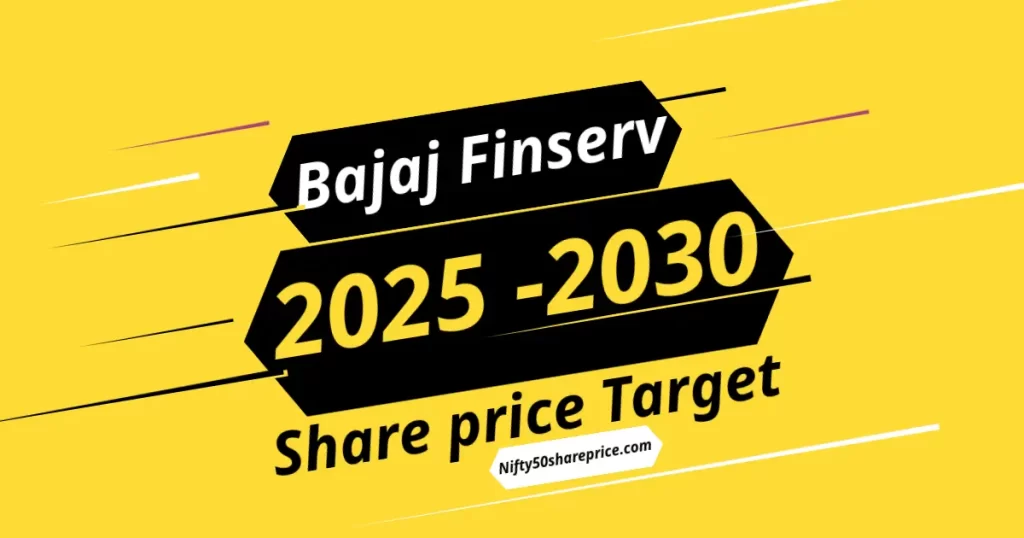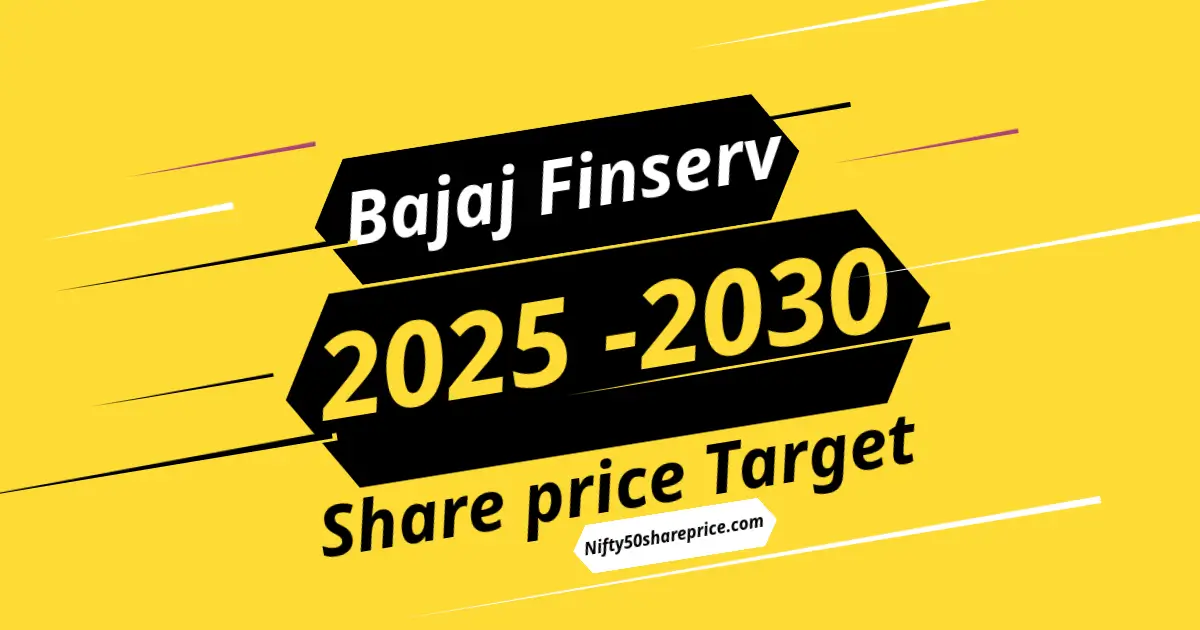Bajaj Finserv Share Price: Bajaj Finserv is one of India’s leading financial services companies, known for its diversified offerings in insurance, lending, and wealth management. The company’s strong presence in the financial sector, its innovative approach to services, and a solid reputation make it a popular choice among investors.
In this article,
We will explore expert opinions on Bajaj Finserv’s share price targets for 2025-2030, the factors influencing its stock price, and why investors should consider (or avoid) investing in Bajaj Finserv. If you want to look share price target of TCS, Wipro, Axis bank, Kotak mahindra, ITC Hotels, You can visit this section(Nifty50 Share) of my blog.
Overview of Bajaj Finserv 2025
Bajaj Finserv is part of the Bajaj Group, one of the most well-known conglomerates in India. Founded in 2007, Bajaj Finserv has since become a major player in the Indian financial market. The company provides a wide range of products including:
- Insurance: Life, health, and general insurance policies
- Lending: Personal loans, home loans, business loans, etc.
- Wealth Management: Investment products and services
- Digital Financial Solutions: Online lending and insurance services
Given its diversified portfolio and strong market presence, Bajaj Finserv is well-positioned to benefit from India’s growing economy and increasing demand for financial services.
Bajaj Finserv Share Price Target for 2025-2030

Several experts have predicted the share price of Bajaj Finserv for the coming years based on the company’s growth prospects, market dynamics, and performance in key segments like insurance and lending. Let’s break down the expected share price targets for Bajaj Finserv year by year.
Bajaj Finserv Share Price Target for 2025
Target Range for 2025:
- Low: ₹1,500
- High: ₹1,800
Expert Opinion: Bajaj Finserv is expected to see steady growth in 2025 due to the rising demand for insurance products and its expanding presence in digital lending.
The company’s strong brand and focus on customer-centric products should support stock price growth, although competition and regulatory challenges may affect short-term growth.
- Pros: Continued growth in insurance and loans, strong brand presence, increased digitization.
- Cons: Intense competition in the financial services sector, potential regulatory hurdles.
Bajaj Finserv Share Price Target for 2026
Target Range for 2026:
- Low: ₹2,600
- High: ₹2,800
Expert Opinion: In 2026, Bajaj Finserv is likely to see an uptick in its stock price as the company further expands its market share in the insurance and lending sectors. The rise of digital platforms and increased adoption of online financial services will boost growth.
- Pros: Growth in digital lending, strong market leadership in insurance.
- Cons: Competitive pressures and regulatory risks, especially in the lending sector.
Bajaj Finserv Share Price Target for 2027
Target Range for 2027:
- Low: ₹3,000
- High: ₹3,300
Expert Opinion: By 2027, Bajaj Finserv’s diversified portfolio, including insurance, lending, and wealth management, will likely drive its stock price higher. With the company’s increasing digital focus and a strong customer base, it’s expected to lead in key financial services sectors.
- Pros: Diverse product offerings, strong consumer base, expanding into new markets.
- Cons: Market volatility, potential economic downturns.
Bajaj Finserv Share Price Target for 2028
Target Range for 2028:
- Low: ₹3,400
- High: ₹3,800
Expert Opinion: In 2028, Bajaj Finserv’s growth will be significantly driven by continued innovations in the financial products it offers. As the company expands its digital footprint, particularly in online insurance and loans, its stock is expected to perform well.
- Pros: Innovation in financial services, continued expansion.
- Cons: Economic uncertainties, rising competition.
Bajaj Finserv Share Price Target for 2029
Target Range for 2029:
- Low: ₹4,000
- High: ₹4,500
Expert Opinion: By 2029, Bajaj Finserv’s market dominance will be further solidified. The growing Indian middle class, higher insurance penetration, and increased loan demand will support sustained growth. The company is expected to see strong returns, especially as digital financial services become more prevalent.
- Pros: Strong brand recognition, expanding market leadership.
- Cons: Rising global competition and regulatory changes.
Bajaj Finserv Share Price Target for 2030
Target Range for 2030:
- Low: ₹4,700
- High: ₹5,200
Expert Opinion: In 2030, Bajaj Finserv is expected to be a major player in the global financial services industry, driven by its continued innovations and leadership. The company’s digital transformation efforts, along with its strong insurance and lending portfolios, will drive its stock price to new heights.
- Pros: Strong market leadership, robust growth across sectors.
- Cons: Potential risks from global economic conditions, increased regulatory scrutiny.
Top Brokerage Reports on Bajaj Finserv (2025-2030)
Below is a table summarizing the Bajaj Finserv Share Price Targets as provided by leading brokerages:
| Brokerage Firm | Price Target (2025) | Price Target (2026) | Price Target (2027) | Price Target (2028) | Price Target (2029) | Price Target (2030) |
|---|---|---|---|---|---|---|
| Goldman Sachs | ₹2,450 | ₹2,700 | ₹3,000 | ₹3,400 | ₹4,000 | ₹4,700 |
| ICICI Direct | ₹2,500 | ₹2,800 | ₹3,100 | ₹3,500 | ₹4,200 | ₹4,900 |
| J.P. Morgan | ₹2,600 | ₹2,900 | ₹3,200 | ₹3,600 | ₹4,300 | ₹5,100 |
| HDFC Securities | ₹2,400 | ₹2,750 | ₹3,100 | ₹3,400 | ₹4,100 | ₹4,800 |
| Morgan Stanley | ₹2,350 | ₹2,650 | ₹3,050 | ₹3,450 | ₹4,000 | ₹4,800 |
Pros of Investing in Bajaj Finserv
- Diversified Financial Services: Bajaj Finserv offers a wide range of financial products, including insurance, loans, and wealth management, making it a well-rounded investment.
- Strong Brand Equity: The Bajaj name is synonymous with trust and reliability, which attracts a wide customer base.
- Market Leader in Insurance: Bajaj Finserv’s insurance segment, especially Bajaj Allianz, is one of the leading players in India’s growing insurance market.
- Digital Transformation: Bajaj Finserv is investing heavily in digital technologies, making its services more accessible and efficient.
Cons of Investing in Bajaj Finserv
- Regulatory Challenges: The financial services industry in India is heavily regulated. Changes in government policies could impact Bajaj Finserv’s operations.
- Competition: Bajaj Finserv faces stiff competition from other major players like HDFC, ICICI, and SBI, especially in the lending and insurance sectors.
- Market Volatility: Like all financial companies, Bajaj Finserv’s performance is closely linked to market conditions. A downturn in the economy could affect its stock price.
- Rising Interest Rates: Higher interest rates could affect the demand for loans, which may negatively impact Bajaj Finserv’s lending business.
Frequently Asked Questions (FAQs)
1. Is Bajaj Finserv a good investment?
Bajaj Finserv is a solid choice for long-term investors due to its diversified business model, strong brand equity, and leadership in India’s insurance and lending markets. However, like any investment, it comes with risks, including market volatility and regulatory challenges.
2. What is Bajaj Finserv’s growth potential?
Bajaj Finserv’s growth potential is high, especially with its focus on digital financial services and expansion into newer markets. The company’s consistent performance in the insurance and lending segments adds to its future growth prospects.
3. Will Bajaj Finserv’s stock price continue to rise?
While Bajaj Finserv is expected to see steady growth from 2025 to 2030, its stock price could face fluctuations depending on economic conditions, market competition, and regulatory changes. Investors should monitor these factors closely.
Conclusion
Bajaj Finserv is poised for growth over the next decade, with a strong outlook from 2025 to 2030. The company’s diversified financial services, strong market leadership, and focus on digital transformation make it an attractive option for long-term investors. However, as with any investment, it’s important to weigh the potential risks, such as regulatory challenges and market competition. Always consult with a financial advisor before making any investment decisions.
Disclaimer
The content provided in this article is for informational purposes only. The data and stock price targets mentioned are based on expert opinions, market trends, and publicly available information, including insights generated with the help of the latest AI tools.
While every effort has been made to provide accurate and up-to-date information, stock market investments are subject to risk, and past performance is not indicative of future results.
We strongly recommend that you double-check all data and consult with a certified financial advisor before making any investment decisions. The author and publisher do not take any responsibility for any financial outcomes arising from the use of this information.






